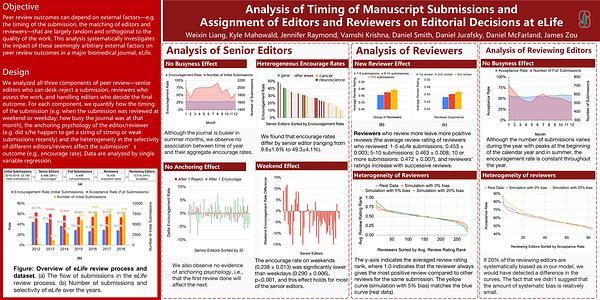Would you like to see your presentation here, made available to a global audience of researchers?
Add your own presentation or have us affordably record your next conference.
Objective As gatekeepers for knowledge production, editors use their backgrounds to determine what counts as high- quality research, how research should be done, and whether it offers novel insights. Individuals who come from racialized backgrounds are often excluded from these conversations, ensuring the publishing world continues to be led by the perspectives of the dominant racial group.1 To address this issue, the journal Teaching and Learning in Medicine (TLM) created an internship program for early career scholars who self-identified as Black, Latinx, or Indigenous to gain experience in the publishing/editorial process.2 The purpose of this study was to critically examine the outcomes of the first 6 months and investigate its implications for other journals interested in similar efforts.
Design A collaborative autoethnographical study was designed to collectively analyze the program. Editorial staff and interns reflected on their lived experiences participating in the internship to understand the current culture of academic publishing and explore how to improve.3 Data sources included archival emails and program planning documents, focus group data, and group exercises. After transcribing the focus groups, data were analyzed using thematic analysis by both editorial staff and interns. Institutional review board approval was not required for this study.
Results Focus group data indicated that while TLM designed the program with antiracist intent, mentors did not foreground their race in the editorial/publishing process outside of the intern’s minoritized status as a program selection criterion. Early on, mentors viewed the internship more as an opportunity to improve the journal’s editorial work, for participants to gain experience working in a historically guarded space, and to contribute to achieving racial equity in medical education. Therefore, despite the program’s specific antiracist focus, 6 months in, none of the mentors (who identified as White individuals) had explicitly discussed topics of race with their interns. Mentors’ reasons for not discussing race varied, including uncertainty about how to invite interns into such a discussion and not seeing interns as racialized individuals. However, at the end of the 6 months, researchers realized the need to discuss this topic, thus moving the program into explicit conversations about race and the role it plays in publishing.
Conclusions Although the program met some antiracist goals, stakeholders did not explicitly discuss the role that race plays in the review process, therefore limiting the program’s initial impact. Through this collaborative autoethnography, TLM stakeholders critically reflected on the program in real time and addressed this gap. In doing so, they engaged in the ongoing critical action needed to support equity within the editorial process. Editorial staff at TLM now have the opportunity to address ongoing power dynamics between interns and staff members that will advance the journal’s efforts at antiracism. Plans are currently underway to ensure interns’ experiences are incorporated.
References
- Salazar JW, Claytor JD, Habib AR, Guduguntla V, Redberg RF. Gender, race, ethnicity, and sexual orientation of editors at leading medical and scientific journals: a cross-sectional survey. JAMA Intern Med. 2021;181(9):1248-1251. doi:10.1001/jamainternmed.2021.2363
- Cianciolo AT. Letter from the editor—Teaching & Learning in Medicine’s anti-racism strategy. Teach Learn Med. 2020;32(5):457-458. doi:10.1080/10401334.2020.1836461
- Chang H, Ngunjiri FW, Hernandez KAC. Collaborative Autoethnography. Left Coast Press; 2013.
Conflict of Interest Disclosures None reported.
Disclaimer This work was prepared by a military or civilian employee of the US government as part of the individual’s official duties and therefore is in the public domain. The opinions and assertions expressed herein are those of the author(s) and do not necessarily reflect the official policy or position of the Uniformed Services University or the US Department of Defense.
Additional Information Anabelle Andon is a co–corresponding author.


